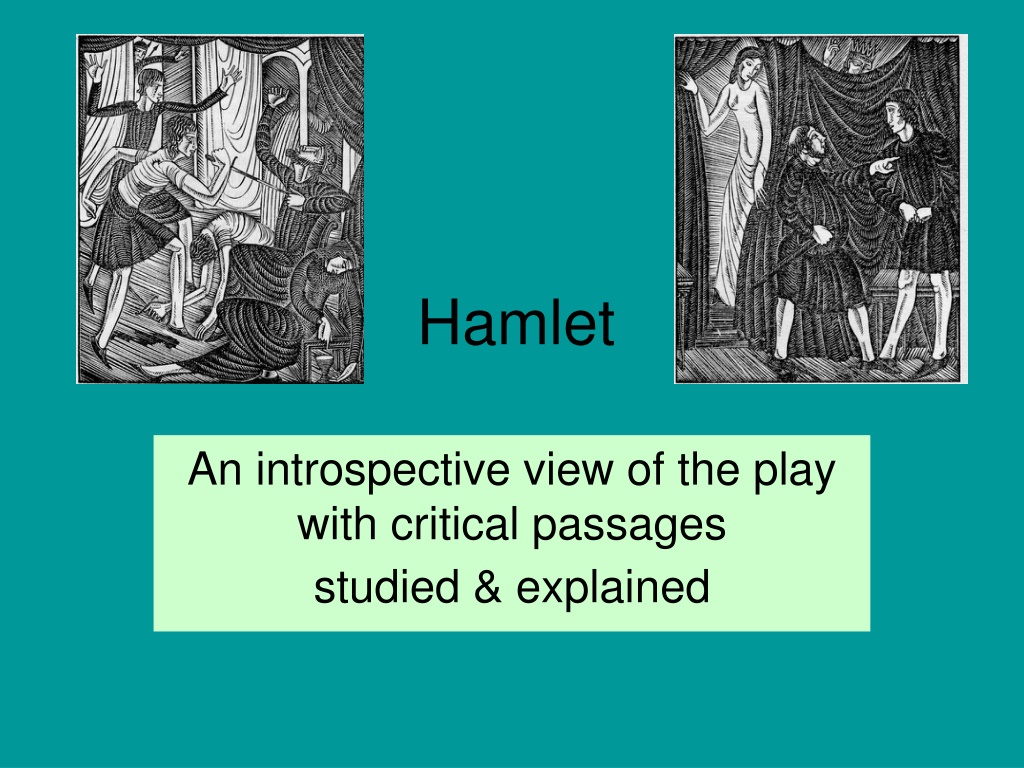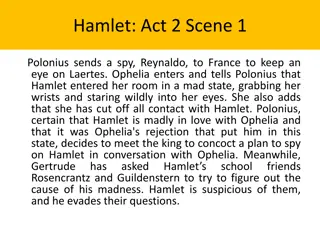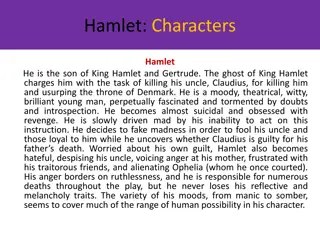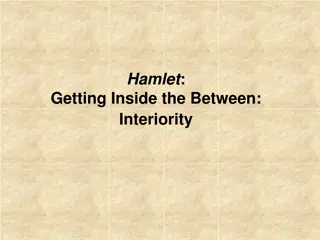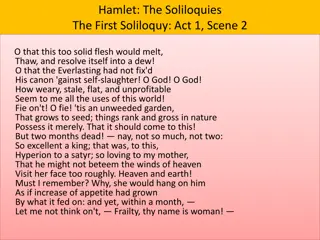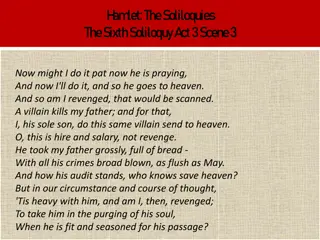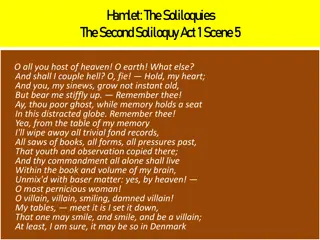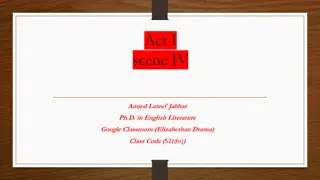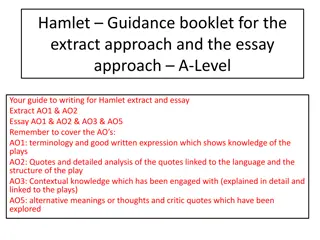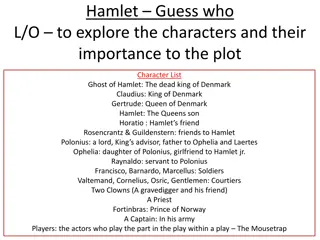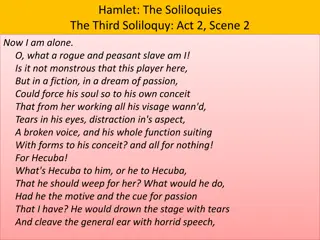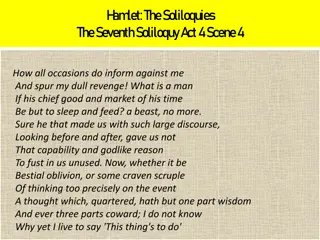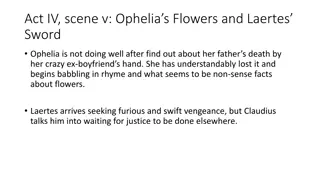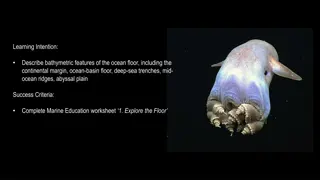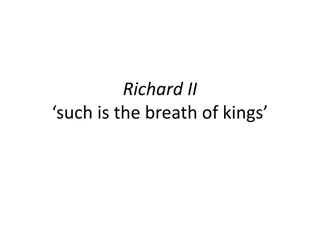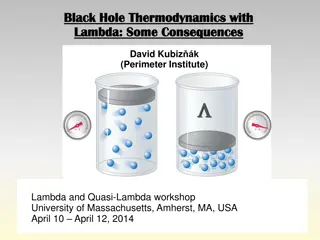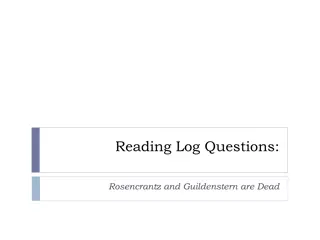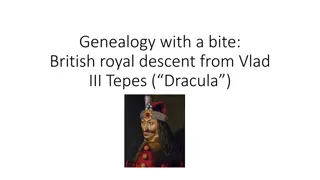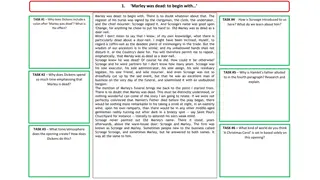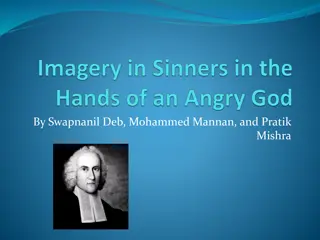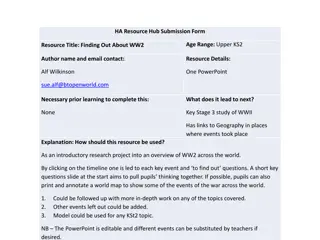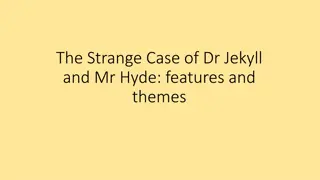Exploring the Intriguing Depths of Shakespeare's Hamlet
Delve into the world of Hamlet, a timeless play by Shakespeare, through critical passages and explanations. Uncover the basic and detailed background information, the dramatic structure overview, basic plot structure, and the genre of revenge tragedy that shape this introspective masterpiece.
Download Presentation

Please find below an Image/Link to download the presentation.
The content on the website is provided AS IS for your information and personal use only. It may not be sold, licensed, or shared on other websites without obtaining consent from the author. Download presentation by click this link. If you encounter any issues during the download, it is possible that the publisher has removed the file from their server.
E N D
Presentation Transcript
Hamlet An introspective view of the play with critical passages studied & explained
Basic Background Information 1600-01 first performed 1603 first printed The plot of the play is not complex. It progresses in a linear fashion, with all events happening in chronological order.
Detailed Background Information Loosely based on Danish history, the play most likely has its origins in Histoires Tragiques, written by Belle- Forest in 1570; much of Belle-Forest's information is drawn from the Historica Danica, written by Saxo Grammaticus in 1208.
In Belle-Forest's version of Hamlet, it is a known fact that Claudius, the King's brother, murders him and takes the throne. Claudius then tries to find reason to have Hamlet, the Prince of Denmark, put to death in order to ensure his retention of the throne. Realizing her error in marrying Claudius, Hamlet's mother begs forgiveness from her son and acts with him to seek vengeance on Claudius. During a banquet, Hamlet sets fire to the dining hall and beheads his uncle, the guilty King of Denmark. Hamlet is then crowned King.
Basic Plot Structure The basic structure of the plot of Hamlet is remarkably simple; a wrong occurs and the hero seeks revenge to make it right. In the process, everyone is destroyed.
Basic Plot Structure Shakespeare develops the plot of his "revenge" tragedy in classical form. Act I is largely expository in nature, introducing the main characters and the conflict. Acts II, III, and IV contain the rising action of the plot as the conflict develops, largely in Hamlet's mind. Act V contains the climax, a short period of falling action, and the denouement, or conclusion, in which Fortinbras takes control of Denmark to bring order to the country once again.
A closer look at the genre The genre of "revenge tragedy" was immensely popular among English Elizabethan dramatists. In typical revenge tragedies, such as Hamlet, the plot arises largely out of a situation for which the hero is not responsible. Additionally, even though the hero may have a tragic flaw that contributes to his downfall, he is usually undone by circumstances over which he has no control.
A closer look (cont.) Accordingly in Hamlet, the crime that calls for vengeance has already been committed before the play begins. The real cause of the tragedy is the evil and intolerable situation surrounding Claudius' murder of Hamlet's father, the King. As Hamlet tries to find a way to avenge his father's death, murder, madness, and ghosts are all brought to the front of the stage, creating interest and tension in the audience.
Motifs& ?s to focus on: The Theme of Vengeance Appearance vs. Reality Some things to consider: Is Hamlet Crazy? Does Hamlet Hesitate? Is life worth living? ... What is a man, If his chief good and market of his time Is but to sleep and feed? A beast, no more. -- Hamlet
Multiple approaches taken Over the years there have been a variety of approaches to the play Hamlet (both on stage and in the analysis of). Hamlet Seen Solely as the Victim of External Difficulties The Romantic Interpretation The Psychoanalytical Approach The Historical Approach
Hamlet Seen Solely as the Victim of External Difficulties the simplest approach to the play With his father dead and his mother remarried to his enemy, Hamlet has no one to turn to for help; therefore, he is totally a victim of circumstance. The critics further argue that the external situation prevents him from taking swift action. After all, Claudius is an extremely powerful man now that he is King; any person would have faced enormous difficulties in scheming against him. They excuse Hamlet's lack of action, and in so doing, make him a much less interesting character.
The Romantic Interpretation The Romantic critics of the nineteenth century, led by Coleridge, were more interested in the character of Hamlet than in the plot construction of the play. For them, Hamlet was one of the greatest artistic creations ever. They saw Hamlet as an individual torn apart by doubt and fearful of taking action. As an idealist, Hamlet was unable to deal with the harsh realities of life; as a result, he paid a tragic penalty. These critics often quoted Hamlet's own words in support of their interpretation.
The Psychoanalytical Approach The psychoanalytical approach focuses on the neurotic tendencies of Hamlet and judges him to suffer from an Oedipus Complex. The psychoanalysts believe that Hamlet's possessiveness towards his mother proves his Oedipal Complex; they defend their arguments in specifics from the play. Hamlet explicitly urges Gertrude not to have intercourse with Claudius; moreover, he advises her to curb her desire to have sex as well.
The Psychoanalytical Approach The psychoanalysts then argue that Hamlet's repressed Oedipal Complex prevents him from killing Claudius. They feel that Hamlet procrastinates because, in his subconscious, he does not really want to murder the man who killed the father that he so envied. They also argue that it is Oedipal Complex prevents him from committing himself to Ophelia.
The Historical Approach The historical approach holds that only those theories prevalent in Shakespeare's time should be utilized to interpret his texts. Supporters of this school of thought argue that the clue to Hamlet's madness and his hesitancy in killing Claudius lies in his melancholic disposition.
The Historical Approach Indeed, Shakespeare calls Hamlet the "melancholy Dane." The malady of melancholy was well known in the Elizabethan age, and several treatises were written on the subject. Shakespeare had probably read or heard about these treatises, which state that the primary characteristics of melancholy are sadness, fear, distrust, doubt, despair, and diffidence. Sometimes the negative feelings are interrupted by a false laughter or sardonic humor.
Passage Explications and commentaries
Activity #1 - 1.1.1-80 Analysis Who are these people? Where are they, and what are they doing? What information does Shakespeare provide about the physical setting? What atmosphere/mood is created by this setting? What do the physical aspects of the setting suggest about the characters behavior? What does the opening question Who s there? imply about Barnardo and about the situation? Does anything in the conversation between Barnardo and Francisco reinforce these implications? What additional information do we gain about Barnardo and Francisco from their conversation? Shakespeare wrote into the body of the play many signals and directions What do the commands and questions in lines 1-20 suggest about staging this scene? What inferences can be drawn about Horatio s character? About his relationship to the guards?
Works Referenced Pinkmonkey Notes http://www.pinkmonkey.com/booknotes/monkeynotes/pm Hamlet02.asp Phelps, Katherine. Having a Climax, the single climax dramatic structure. 1997. http://www.glasswings.com.au/Storytronics/Tronics/plot/s ingle8.htm Images: http://library.wustl.edu/units/spec/exhibits/enchant/images/hamle t-gill1.jpg http://celebrating-humanity.wikispaces.com/file/view/hamlet- gill2.jpg/30404793/hamlet-gill2.jpg http://etc.usf.edu/clipart/5800/5805/hamlet_8_lg.gif
